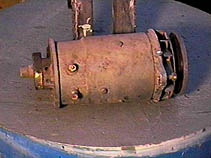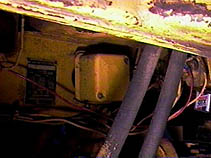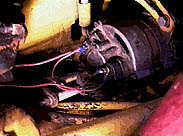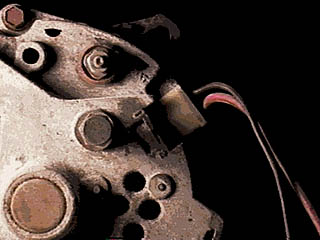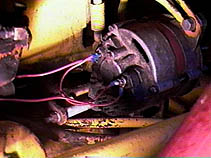of Your Older Tractor by Tyler Woods
Older tractors have externally regulated generators or externally regulated alternators, in some instances. That means there is one device that turns energy from the fan belt into electrical energy,
and another device, called a regulator, that keeps the voltage from overcharging the battery. (yellow box in this picture) This is a very simple description but it will work for our needs. Modern alternators offer improvement to an older tractor's charging system and cost far less. This article addresses the electrical adaptation of a modern alternator to an older tractor. I reference the Delco alternator used in most GM late 70s cars and trucks with a 350 cu. in. V8 engine. (Type #GM 10 SI, Model 7127, Cost is roughly $35), but nearly all internally regulated alternators have the same output wiring. I used a Datsun alternator for my Massey Ferguson because the diameter was the same as the original generator. Before you begin you need to make sure your system is a 12v, negative ground charging system. If your battery is 12v and the negative (-) post is connected to the chassis or engine block, your system is 12v negative ground. If your system is something else, you must make this conversion before continuing with an alternator upgrade. First, you need to remove the previous charging system (generator or alternator, including the associated voltage regulator.) You may wish to save these parts for a future classic restoration. A wiring diagram is VERY helpful here. Many manufacturers use the regulator terminals for convenient power distribution to other ignition parts (like the ignition switch). Note wires from instruments or parts other than the generator/alternator and be ready to replace their function either by routing them differently or by adding jumpers. My tractor needed only one jumper wire to supply power to the ignition switch after removing the regulator, generator and associated wiring. Take care not to leave dangling wires on your tractor. Remove unused wires completely. Mechanical mounting is going to be a case by case issue. I replaced Massey Ferguson generator, with a Datsun alternator, and only needed to use a longer bolt for the mounting lugs and some ¼" galvanized pipe, cut for a spacer.
regulation is only controlled at the alternator output post. When the sense line is attached at the battery or starter, the regulator will compensate for line loss and regulation will be controlled for the destination. You may have seen work lights that brighten as the engine RPM increases. This can be controlled with proper use of the sense line. I attached my sense line to the output post of my alternator anyway. I figure the lines are short on a tractor and I may not have enough line resistance to notice any fluctuation in my lights. If I do find my lights brighten with RPM, Ill rewire my sense line to either the positive battery post or the starter solenoid.
NOTE: If you have some other internally regulated alternator than the Delco and aren't sure which lead is the sense lead and which is the field (or exciter), you can watch closely as you touch each to power. The sense lead will never draw enough current to cause a spark but the field will.
We sell tractor parts! We have the parts you need to repair your tractor - the right parts. Our low prices and years of research make us your best choice when you need parts. Shop Online Today. Copyright © 1997-2024 Yesterday's Tractor Co. All Rights Reserved. Reproduction of any part of this website, including design and content, without written permission is strictly prohibited. Trade Marks and Trade Names contained and used in this Website are those of others, and are used in this Website in a descriptive sense to refer to the products of others. Use of this Web site constitutes acceptance of our User Agreement and Privacy Policy TRADEMARK DISCLAIMER: Tradenames and Trademarks referred to within Yesterday's Tractor Co. products and within the Yesterday's Tractor Co. websites are the property of their respective trademark holders. None of these trademark holders are affiliated with Yesterday's Tractor Co., our products, or our website nor are we sponsored by them. John Deere and its logos are the registered trademarks of the John Deere Corporation. Agco, Agco Allis, White, Massey Ferguson and their logos are the registered trademarks of AGCO Corporation. Case, Case-IH, Farmall, International Harvester, New Holland and their logos are registered trademarks of CNH Global N.V.
Yesterday's Tractors - Antique Tractor Headquarters |


